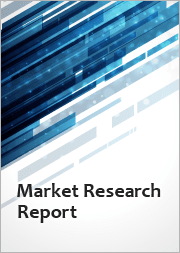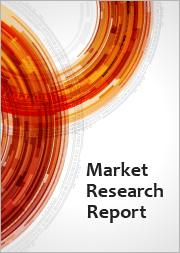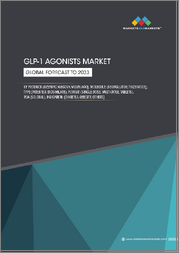
|
시장보고서
상품코드
1727108
미국의 바이오시밀러 시장 : 제품 클래스별, 적응증별, 유통 채널별, 지역별, 기회, 예측(2018-2032년)United States Biosimilars Market Assessment, By Product Class, By Indication By Distribution Channel, By Region, Opportunities and Forecast, 2018-2032F |
||||||
미국의 바이오시밀러 시장 규모는 2025-2032년의 예측 기간 중 15%의 CAGR로 확대하며, 2024년 95억 2,000만 달러에서 2032년에는 291억 2,000만 달러로 성장할 것으로 예측됩니다. 미국의 바이오시밀러 시장은 헬스케어 비용의 상승과 특히 종양 및 만성질환에서 저렴한 치료 옵션에 대한 수요로 인해 성장하고 있습니다. 호환성 지정 및 자동 대체법 등의 규제 개혁은 바이오시밀러의 도입을 가속화하고 있습니다. 동시에 주요 기업의 제품 파이프라인 확장 및 전략적 구상은 시장에서의 입지와 환자 접근성을 강화하고 있습니다.
미국의 바이오시밀러 시장에 대해 조사했으며, 시장의 개요와 제품 클래스별, 적응증별, 유통 채널별, 지역별 동향 및 시장에 참여하는 기업의 개요 등을 제공하고 있습니다.
목차
제1장 프로젝트 범위와 정의
제2장 조사 방법
제3장 미국 관세의 영향
제4장 개요
제5장 미국 바이오시밀러 시장 전망, 2018-2032년
- 시장 규모 분석과 예측
- 시장 점유율 분석과 예측
- 제품 클래스별
- 모노클로널 항체
- 재조합 호르몬
- 면역 조절제
- 항염증약
- 기타
- 적응증별
- 종양학
- 성장호르몬 결핍증
- 혈액 질환
- 만성질환 및 자가면역질환
- 감염증
- 기타
- 유통 채널별
- 병원
- 암케어 센터
- 기타
- 지역별
- 북서부
- 남서부
- 서부
- 남동부
- 중서부
- 기업별 시장 점유율 분석(상위 5사 및 기타 - 금액별, 2024년)
- 제품 클래스별
- 2024년 시장 맵 분석
제6장 수요공급 분석
제7장 밸류체인 분석
제8장 Porter's Five Forces 분석
제9장 PESTLE 분석
제10장 가격 분석
제11장 시장 역학
- 시장 촉진요인
- 시장이 해결해야 할 과제
제12장 시장 동향과 발전
제13장 규제 구조와 혁신
- 규제기관의 승인
- 임상시험
제14장 특허의 상황
제15장 사례 연구
제16장 경쟁 구도
- 시장 리더 TOP 5의 경쟁 매트릭스
- 참여 기업 TOP 5의 SWOT 분석
- 시장의 주요 기업 TOP 10의 상황
- Novartis AG
- Pfizer, Inc.
- Dr. Reddy's Laboratories Ltd.
- Amgen, Inc.
- Eli Lilly and Company
- Celltrion Inc.
- Teva Pharmaceuticals, Inc.
- Viatris Inc.
- Samsung Bioepis Co., Ltd.
- Bristol-Myers Squibb Company
제17장 전략적 제안
제18장 조사회사 소개·면책사항
KSA 25.06.05United States biosimilars market is projected to witness a CAGR of 15% during the forecast period 2025-2032, growing from USD 9.52 billion in 2024 to USD 29.12 billion in 2032. The U.S. biosimilars market is being propelled by rising healthcare costs and demand for affordable treatment options, especially in oncology and chronic conditions. Regulatory reforms such as interchangeability designations and automatic substitution laws are accelerating biosimilar uptake. Simultaneously, expanding product pipelines and strategic initiatives by key players strengthen market presence and patient access.
Increasing Healthcare Cost Burden Driving Demand for Cost-Effective Biosimilars
The increasing expenses associated with biologic therapies in the United States have heightened the need for more cost-effective biosimilars. As the healthcare system faces challenges from the prevalence of chronic diseases, an aging population, and inflationary pressures, biosimilars present a viable alternative that maintains efficacy while being more affordable. Typically, biosimilars are introduced to the market at prices 15-35% lower than their reference biologics, which significantly alleviates treatment costs for both patients and healthcare providers. Their adoption is especially prominent in high-cost therapeutic fields such as oncology and autoimmune diseases. Additionally, the growing emphasis on value-based care by payers and the strategic placement of biosimilars in formularies are further promoting their use. Government initiatives, including the Biologics Price Competition and Innovation Act (BPCIA), continue to facilitate quicker approvals and enhance market competition. In December 2023, Pfizer reported a 43% year-over-year growth in its biosimilars portfolio in the U.S., largely driven by oncology biosimilars like ZIRABEV and NYVEPRIA. This momentum underscores how healthcare systems and providers are embracing biosimilars to enhance access, reduce drug expenditure, and improve long-term sustainability.
Expanding Oncology Indications Accelerating Market Penetration
Biosimilars are rapidly gaining popularity in oncology, a crucial sector of the U.S. pharmaceutical industry. The expiration of patents for several leading monoclonal antibodies (mAbs), including trastuzumab, rituximab, and bevacizumab, has created significant opportunities for biosimilar producers. Given that oncology treatment regimens are generally long-term and costly, they represent an ideal candidate for biosimilar replacement. The acceptance of biosimilars in clinical settings has grown as oncologists become more assured of their safety and efficacy, supported by real-world data and endorsements from the FDA. Furthermore, healthcare systems and cancer treatment centers are promoting the use of biosimilars by incorporating them into their formularies and treatment guidelines. For instance, in October 2024, Teva Pharmaceuticals and mAbxience announced an expanded collaboration agreement for the development of an anti-PD1 oncology biosimilar candidate. These advancements highlight the strategic importance of oncology in shaping biosimilar growth. The continuous pipeline of new biosimilars targeting oncologic indications is expected to further strengthen this trend, creating a ripple effect across other specialty therapeutic areas.
Supportive Regulatory Reforms and Regional Initiatives Boosting Market Expansion
The U.S. FDA has optimized the biosimilar approval process through the BPCIA, creating a more advantageous regulatory landscape for biosimilar developers. These modifications have led to shorter approval periods, enhanced interchangeability designations, and heightened trust among prescribers. On a regional level, states are enacting automatic substitution laws that permit pharmacists to replace interchangeable biosimilars without needing physician consent, thereby further promoting adoption. Additionally, the FDA's educational initiatives, including the 'Biosimilars Action Plan,' are significantly contributing to the enhancement of awareness among providers and patients. On April 14, 2025, Celltrion declared that the FDA has granted its adalimumab-aaty (marketed as YUFLYMA) an interchangeable designation. This biosimilar is based on adalimumab (known as Humira). The FDA has approved adalimumab-aaty as a high-concentration (100mg/mL) and citrate-free formulation of the reference biologic adalimumab for the treatment of various inflammatory conditions. Regional expansion is notably apparent in states with significant Medicaid participation, where biosimilars are regarded as a cost-effective alternative. With increasing regulatory backing, it is anticipated that biosimilar manufacturers will gain enhanced market access, higher adoption rates, and diminished resistance to pricing.
Future Market Scenario (2025-2032F)
The U.S. biosimilars market is set for substantial expansion in the coming decade, fueled by the expiration of patents for major biologics, rising demands to lower healthcare expenses, and supportive regulatory changes that facilitate biosimilar approvals and their interchangeability. The growing range of therapeutic uses for biosimilars in fields such as oncology, autoimmune disorders, and endocrinology will further enhance demand. As healthcare providers and payers gain greater confidence in the safety and effectiveness of biosimilars, a wider acceptance in various healthcare environments, including hospitals, cancer treatment centers, and specialized clinics-is anticipated. Moreover, increased investments from leading pharmaceutical firms and greater patient awareness will enhance market penetration. By the year 2030, the biosimilars market is expected to play a pivotal role in transforming specialty drug pricing and improving access to essential therapies for patients in the United States.
Key Players Landscape and Outlook
The key players in the market are significantly investing in the development of biosimilars and are utilizing strategies such as mergers, acquisitions, partnerships, and new product launches to improve their services and competitiveness. Such efforts will propel significant growth in the market, allowing large-cap industry players to increase their presence and, therefore, find new opportunities in this market.
For instance, Teva Pharmaceuticals and Alvotech have officially announced the launch of Selarsdi (ustekinumab-aekn) injection in the United States, which is a biosimilar to Johnson & Johnson's Stelara (ustekinumab). This medication is approved for treating Crohn's disease, pediatric plaque psoriasis, pediatric psoriatic arthritis, plaque psoriasis, psoriatic arthritis, and ulcerative colitis. This represents the second biosimilar introduced in the country as a result of the strategic partnership between the two companies.
Table of Contents
1. Project Scope and Definitions
2. Research Methodology
3. Impact of U.S. Tariffs
4. Executive Summary
5. United States Biosimilars Market Outlook, 2018-2032F
- 5.1. Market Size Analysis & Forecast
- 5.1.1. By Value
- 5.2. Market Share Analysis & Forecast
- 5.2.1. By Product Class
- 5.2.1.1. Monoclonal Antibodies
- 5.2.1.1.1. Adalimumab
- 5.2.1.1.2. Infliximab
- 5.2.1.1.3. Rituximab
- 5.2.1.1.4. Trastuzumab
- 5.2.1.1.5. Others
- 5.2.1.2. Recombinant Hormones
- 5.2.1.2.1. Insulin
- 5.2.1.2.2. Erythropoietin
- 5.2.1.2.3. Others
- 5.2.1.3. Immunomodulators
- 5.2.1.4. Anti-Inflammatory Agents
- 5.2.1.5. Others
- 5.2.1.1. Monoclonal Antibodies
- 5.2.2. By Indication
- 5.2.2.1. Oncology
- 5.2.2.2. Growth Hormone Deficiency
- 5.2.2.3. Blood Disorders
- 5.2.2.4. Chronic and Autoimmune Disorders
- 5.2.2.5. Infectious Diseases
- 5.2.2.6. Others
- 5.2.3. By Distribution Channel
- 5.2.3.1. Hospitals
- 5.2.3.2. Cancer Care Centers
- 5.2.3.3. Others
- 5.2.4. By Region
- 5.2.4.1. Northwest
- 5.2.4.2. Southwest
- 5.2.4.3. West
- 5.2.4.4. Southeast
- 5.2.4.5. Midwest
- 5.2.5. By Company Market Share Analysis (Top 5 Companies and Others - By Value, 2024)
- 5.2.1. By Product Class
- 5.3. Market Map Analysis, 2024
- 5.3.1. By Product Class
- 5.3.2. By Indication
- 5.3.3. By Distribution Channel
- 5.3.4. By Region
6. Demand Supply Analysis
7. Value Chain Analysis
8. Porter's Five Forces Analysis
9. PESTLE Analysis
10. Pricing Analysis
11. Market Dynamics
- 11.1. Market Drivers
- 11.2. Market Challenges
12. Market Trends and Developments
13. Regulatory Framework and Innovation
- 13.1. Regulatory Approvals
- 13.2. Clinical Trials
14. Patent Landscape
15. Case Studies
16. Competitive Landscape
- 16.1. Competition Matrix of Top 5 Market Leaders
- 16.2. SWOT Analysis for Top 5 Players
- 16.3. Key Players Landscape for Top 10 Market Players
- 16.3.1. Novartis AG
- 16.3.1.1. Company Details
- 16.3.1.2. Key Management Personnel
- 16.3.1.3. Products and Services
- 16.3.1.4. Financials (As Reported)
- 16.3.1.5. Key Market Focus and Geographical Presence
- 16.3.1.6. Recent Developments/Collaborations/Partnerships/Mergers and Acquisition
- 16.3.2. Pfizer, Inc.
- 16.3.3. Dr. Reddy's Laboratories Ltd.
- 16.3.4. Amgen, Inc.
- 16.3.5. Eli Lilly and Company
- 16.3.6. Celltrion Inc.
- 16.3.7. Teva Pharmaceuticals, Inc.
- 16.3.8. Viatris Inc.
- 16.3.9. Samsung Bioepis Co., Ltd.
- 16.3.10. Bristol-Myers Squibb Company
- 16.3.1. Novartis AG
Companies mentioned above DO NOT hold any order as per market share and can be changed as per information available during research work.



















